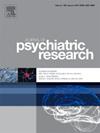The effect of the Apollo Neuro device on anxiety among participants who underwent ketamine assisted therapy
IF 3.2
2区 医学
Q1 PSYCHIATRY
引用次数: 0
Abstract
Background
The Apollo wearable device (wrist or ankle) is an investigational device which provides touch therapy with silent vibrations that may help individuals reduce the symptoms of stress such as difficulty breathing, sleeping or focusing on tasks. Positive feedback from a mental health treatment program that uses ketamine-assisted therapy as a treatment adjunct inspired researchers to assess the impact of the Apollo Neuro device on anxiety levels, comparing those using the device with those not using the device.
Methods
RTT-KAT is 12-weeks in length, with 30 min of curriculum, and 1.5 h of virtual CoP integration sessions each week. Patients receive group ketamine treatment at weeks 4,6,8 of the 12-week program. Intramuscular, gluteal, or deltoid injections of ketamine in the weight-based range of 0.5–1.5 mg/kg were used for each treatment. Doses ranged from 45 to 145 mg per session. The primary outcome measure was the change in Generalized Anxiety Disorder 7-item (GAD-7) scores, calculated as the difference between pre-GAD-7 and post-GAD-7 scores between patients with and without the Apollo Neuro device.
Data analysis
Data cleaning was performed to handle missing values and non-numeric entries. Propensity score matching was used to match participants from the “Apollo” and “Control” groups based on demographic and baseline GAD-7 scores. An independent sample t-test was conducted to compare the mean change in GAD-7 scores between the two groups.
Results
Sixteen Apollo participants and 18 Control group participants were included in final analysis. Shapiro test did not suggest non-normality of GAD-7 change over the duration of the treatment program. Without pre-balancing of age/sex/pre-gad-7, an independent Welch Two Sample t-test was conducted to compare the mean change in GAD-7 scores between the two groups. There was no significant difference (p = 0.572).
Discussion
Despite limitations of randomization and diversified participant groups, GAD-7 score analysis revealed median reduction in anxiety symptoms both with and without the Apollo Neuro device. However, with propensity-score balancing of baseline factors, there was no significant difference between the Apollo and Control groups (p = 0.63).
阿波罗神经装置对接受氯胺酮辅助治疗的参与者焦虑的影响。
背景:阿波罗可穿戴设备(手腕或脚踝)是一种实验性设备,它提供无声振动的触摸治疗,可以帮助个人减轻压力症状,如呼吸困难、睡眠困难或专注于任务。一项使用氯胺酮辅助治疗的心理健康治疗项目的积极反馈,激发了研究人员对阿波罗神经设备对焦虑水平的影响进行评估,将使用该设备的人与不使用该设备的人进行比较。方法:RTT-KAT为期12周,课程30分钟,每周1.5小时的虚拟CoP整合会议。患者在12周疗程的第4、6、8周接受氯胺酮组治疗。每次治疗均采用肌肉、臀肌或三角肌注射氯胺酮,剂量以体重为基础,为0.5-1.5 mg/kg。每次的剂量从45毫克到145毫克不等。主要结局测量指标是广泛性焦虑障碍7项(GAD-7)评分的变化,以使用和不使用阿波罗神经装置的患者GAD-7前和GAD-7后评分的差异计算。数据分析:执行数据清理以处理缺失值和非数字项。根据人口统计和基线GAD-7评分,使用倾向评分匹配来匹配“阿波罗”组和“对照组”组的参与者。采用独立样本t检验比较两组间GAD-7评分的平均变化。结果:阿波罗组16例,对照组18例纳入最终分析。夏皮罗试验未提示GAD-7在治疗过程中的异常变化。在未预平衡年龄/性别/预GAD-7的情况下,采用独立Welch双样本t检验比较两组间GAD-7评分的平均变化。差异无统计学意义(p = 0.572)。讨论:尽管随机化和多样化参与者组存在局限性,但GAD-7评分分析显示,使用和不使用阿波罗神经装置时,焦虑症状的中位数减少。然而,在基线因素的倾向-评分平衡中,阿波罗组和对照组之间没有显著差异(p = 0.63)。
本文章由计算机程序翻译,如有差异,请以英文原文为准。
求助全文
约1分钟内获得全文
求助全文
来源期刊

Journal of psychiatric research
医学-精神病学
CiteScore
7.30
自引率
2.10%
发文量
622
审稿时长
130 days
期刊介绍:
Founded in 1961 to report on the latest work in psychiatry and cognate disciplines, the Journal of Psychiatric Research is dedicated to innovative and timely studies of four important areas of research:
(1) clinical studies of all disciplines relating to psychiatric illness, as well as normal human behaviour, including biochemical, physiological, genetic, environmental, social, psychological and epidemiological factors;
(2) basic studies pertaining to psychiatry in such fields as neuropsychopharmacology, neuroendocrinology, electrophysiology, genetics, experimental psychology and epidemiology;
(3) the growing application of clinical laboratory techniques in psychiatry, including imagery and spectroscopy of the brain, molecular biology and computer sciences;
 求助内容:
求助内容: 应助结果提醒方式:
应助结果提醒方式:


